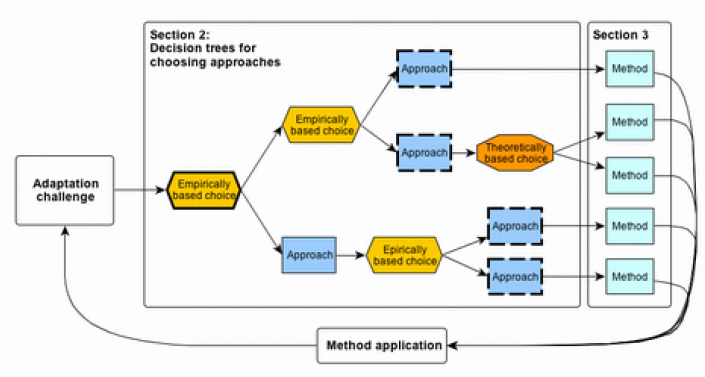This guidance presents the relevant criteria for choosing approaches for an adaptation challenge in the form of decision trees, in which decision nodes on empirical, theoretical and normative criteria lead to different approaches. The analyst enters a decision tree via entry points decision node. Some approaches are intermediate tasks in that they lead to subsequent decision nodes within the same decision tree. Other tasks are exit points in that they are tasks which lead to address the next stage in the overall adaptation cycle.

Figure 1.2: Exemplary decision tree and its iterative application for choosing approaches
based on the current adaptation challenge. Decision nodes on empirical criteria are
represented by yellow hexagons, decision nodes on theoretical criteria are represented by
orange octagons. The salient approaches are represented by blue rectangles. The entry point
to a decision tree is a decision node with bold borders. Exit points are approaches that lead
to addressing the next stage in the overall adaptation cycle. They are represented with dashed
bold borders.
The guidance document is structured as represented in Figure 1.2: The pathfinder provides guidance on choosing the appropriate approach based on the adaptation challenge and the Toolbox provides more specific guidance on the approaches as well as available methods and tools. The decision trees are accompanied by an explanatory text, which walks the reader through each node in a decision tree, and the implications of this node for the identification salient approaches.
It must be noted that the arrows are intended to show a rough indication of which approach might be salient. In many cases, it may not be possible to provide a definitive answer in regards to the sequence of approaches. For example, the greater amount of resources required to carry out impact analysis imply that when resources are constrained capacity analysis is appropriate. This guidance does not, however, prescribe a precise threshold where capacity analysis should be carried out instead of impact analysis, rather the document provides explicit criteria for making these choices.
Importantly, there is no predefined sequence of approaches. Approaches are identified and methods applied iteratively. Based on the current knowledge of the adaptation challenge, an initial approach is selected and applied, new insights are gained, which in turn leads to the formulation of a new adaptation challenge (see Figure 1.2).